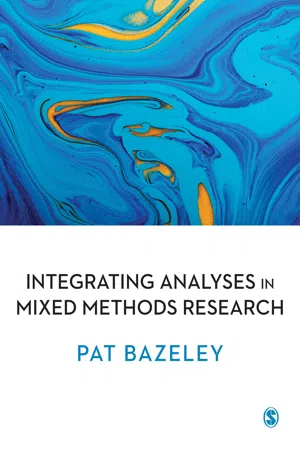Data Interpretation
Data interpretation involves analyzing and making sense of data to draw meaningful conclusions. It encompasses techniques such as statistical analysis, visualization, and pattern recognition to extract valuable insights from data sets. In mathematics, data interpretation is crucial for understanding real-world phenomena and making informed decisions based on empirical evidence.
6 Key excerpts on "Data Interpretation"
- eBook - ePub
GRE - Quantitative Reasoning
QuickStudy Laminated Reference Guide
- (Author)
- 2018(Publication Date)
- QuickStudy Reference Guides(Publisher)
...Data Interpretation Topics include basic descriptive statistics, such as mean, median, mode, range, standard deviation, interquartile range, quartiles, and percentiles; interpretation of data in tables and graphs, such as line graphs, bar graphs, circle graphs, boxplots, scatterplots, and frequency distributions; elementary and conditional probability, such as probabilities of compound events and independent events; random variables and probability distributions, including normal distributions; and counting methods, such as combinations, permutations, and Venn diagrams. Graphs Bar graphs are used to compare the quantities of items, track changes over time, and compare different times. The x -axis, which runs horizontally, includes the time periods or the names of the items that are being compared. The y -axis, which runs vertically, includes the increments of measurement. Circle graphs are used to show percentages of a whole at a set point in time. Line graphs are used to show changes over time...
- eBook - ePub
Becoming a Teacher through Action Research
Process, Context, and Self-Study
- Donna Kalmbach Phillips, Kevin Carr(Authors)
- 2014(Publication Date)
- Routledge(Publisher)
...Even statistical analyses based strictly on numerical data don’t simply speak “truth” on their own. Someone, a subjective person, has to interpret the results. But while all interpretation is subjective, there are methodologies that make interpretation personal without falling into the untrustworthy trap of self-centered babble. In the next section, you will practice and apply some of these methodologies. Finally, a reminder: as you embark upon final Data Interpretation (is there a drum roll?): stay open —there may be an “astonishing disclosure” sitting right next to you. Travel the side road Cultural Context 6.1: The Numbers Tell the Story, found at the end of this chapter on p. 175. General Steps for Data Interpretation Here we outline the general steps of the Data Interpretation process. Note, however, that the notion of “steps” can be deceptive. Steps can make a process look simple, linear, and even rigid when in fact they require critical thought and fluidity on the part of the researcher. These steps are meant to be useful in providing a scaffold for the Data Interpretation process as presented here. This is not the way, but one way of approaching Data Interpretation that has been useful to the many preservice teacher-researchers with whom we teach and learn. There are other ways to undertake Data Interpretation; perhaps you will invent your own process. However you arrive at the end of Data Interpretation, the goal is still the same: making meaning of the data. The six steps of the Data Interpretation process are generally as follows (see Figure 6.2): 1. Revisit, reflect on, and reread data and perform ongoing analysis. Synthesize across the data by creating mind maps, charts, highlighting data, and/or creating timelines. 2. Create tentative category headings of interpretation. 3. Expand your interpretation. Add raw data to the interpretation. 4. Apply interpretative layers. Add the perspectives of others. 5. Return to the questions...
- eBook - ePub
- Alan Berkeley Thomas(Author)
- 2004(Publication Date)
- Routledge(Publisher)
...12 Data analysis and interpretation The range of techniques available for the analysis and interpretation of both quantitative and qualitative data is enormous. A full account of statistical methods alone would fill many volumes. The purpose of this chapter is therefore to provide an overview of the main methods of analysis and to indicate their potential applications rather than to give detailed instruction in how particular statistics are calculated or how to undertake textual interpretation. Guidance to sources dealing with these topics in depth is given at the end of the chapter. Basic processes: describing and explaining Once the dataset has been constructed, its contents must be analysed and interpreted. The accumulated body of data does not speak for itself. At this stage the researcher has to confront two key problems: How can the data be transformed from an extensive assortment of raw materials into a concise and meaningful description of what has been observed? Once a valid and coherent descriptive account has been constructed, how can it be connected with the problem field? Have new descriptive materials been created? Have theoretical expectations been tested? Has a new theory or causal model been constructed? These questions must, of course, be tackled in relation to the overall objectives of the study, but the general aim of analysis and interpretation is to enable the analyst to ‘see the wood for the trees’. The analyst seeks structure in the data: generalities and commonalities within all the variety and the differences that are displayed in the dataset, and linkages, patterns and connections among elements, variables, categories and types. Data can mount up alarmingly as a study progresses: datasets may swell and field notes bulge to the point where it may seem impossible to make any sense out of the material...
- eBook - ePub
- Patricia Bazeley(Author)
- 2017(Publication Date)
- SAGE Publications Ltd(Publisher)
...3 Interpreting Data Chapter overview The task of data analysis An interpretive orientation to data and analysis Interpreting statistical and non-numeric data sources – some cautionary notes Cautions in interpreting numeric data and statistical tests Interpreting text: beyond descriptive accounts Keeping track of research decisions, activities and reflections A framework for mixed methods analysis Typological and dimensional frameworks for integrated analysis A process-oriented logic model for integrated analysis Starting points (resources) for mixed methods analysis First level processes Second level processes Interpretive outcomes and applications Concluding remarks Further reading Interpreting data and drawing inferences from data is never a straightforward, cut and dried activity, but rather is subject to the vagaries of design decisions, administrative choices, procedural fashions, and contextual influences. Capacity for data analysis involves being able to view the world from the position of another, combined with skills in critical thinking that are applied to the interrogation and interpretation of data. Inferences drawn should make sense to those who contributed the data, to other researchers working with that or similar data, and in the light of what is already known – to which they should, hopefully, add further insights. Specific strategies for working with, analysing, and integrating mixed methods data are the subject of Part 2 of this book. The topic of generating and supporting conclusions built from mixed methods data is covered in Part 3. My primary purpose in this chapter is to provide a conceptual and practical framing for interpretation of data. It presents a perspective that sees all forms of analysis, whether statistical, qualitative, or mixed, as being essentially interpretive...
- eBook - ePub
Assessing Impact
Evaluating Professional Learning
- Joellen S. Killion(Author)
- 2017(Publication Date)
- Corwin(Publisher)
...9 Interpret Data Planning Phase Assess evaluability Formulate evaluation questions Construct the evaluation framework Conducting Phase Collect data Organize, analyze, and display data Interpret data Reporting Phase Report, disseminate, and use findings Evaluate the evaluation Closely linked with data analysis is Data Interpretation. Many, in fact, view analysis and interpretation as a single step, yet they are treated separately in this process because the distinction is significant. Interpretation is the meaning-making process that comes after the data have been organized, counted, sorted, analyzed, and displayed and requires the engagement of stakeholders and preferably program participants. At this step of the process the evaluator seeks to answer the following questions: Who will be involved in the Data Interpretation process? What do these analyzed data mean? How do stakeholders and participants interpret these analyzed data? What do these analyzed data mean in terms of the program’s future? What recommendations can we (the evaluator, stakeholders, and participants) make about the program and its effects? Michael Quinn Patton (2015) offers a detailed description of this step of the evaluation process: Interpretation, by definition, involved going beyond the descriptive data. Interpretation means attaching significance to what was found, making sense of findings, offering explanations, drawing conclusions, extrapolating lessons, making inferences, considering meanings, and otherwise imposing order on an unruly but surely patterned world. The rigors of interpretation and bringing data to bear on explanations include dealing with rival explanations, accounting or disconfirming cases, and accounting for data irregularities as part of testing the viability of an interpretation. All of this is expected—and appropriate—as long as the researchers own the interpretation and make clear the differences between description and interpretation. (p...
- eBook - ePub
Completing Your EdD
The Essential Guide to the Doctor of Education
- Iona Burnell Reilly, Jodi Roffey-Barentsen, Iona Burnell, Jodi Roffey-Barentsen(Authors)
- 2020(Publication Date)
- Emerald Publishing Limited(Publisher)
...7 ANALYSING AND INTERPRETING DATA Jim Crawley INTRODUCTION With appropriate, carefully planned, high-quality data analysis and interpretation, you will almost always get the best from your data and will take significant steps towards the answer/s to your research question/s and meeting your research objectives. Researchers usually find the process of analysing and interpreting the data they have gathered one of the most rewarding parts of the whole experience. This stage of your research should be exciting, informing, absorbing and fulfilling. From the moment your first piece of data has been collected, analysis and interpretation start to take place, even if at that early stage this takes place informally and mainly in your head. The early analysis and interpretation of data will give you a strong impression of the success (or otherwise) of the research to date. As the process continues, the stories from your data unfold. When data analysis is successful, the stories unfold naturally and clearly, and they will illuminate and bring your findings to life as you have planned, intended and hoped. There are, of course, also challenges with analysing and interpreting data. You may, like many researchers before you, feel weighed down under the pressure of analysing large (or small) quantities of complex data, and the stage of your research which was supposed to lead smoothly to your discussion and conclusions becomes a difficult situation where alterations, additions, shifts of emphasis and even changes of direction may need to be made. However well you prepare and organise for data analysis and interpretation, part of the excitement of carrying out research is that it can never be entirely predictable...





